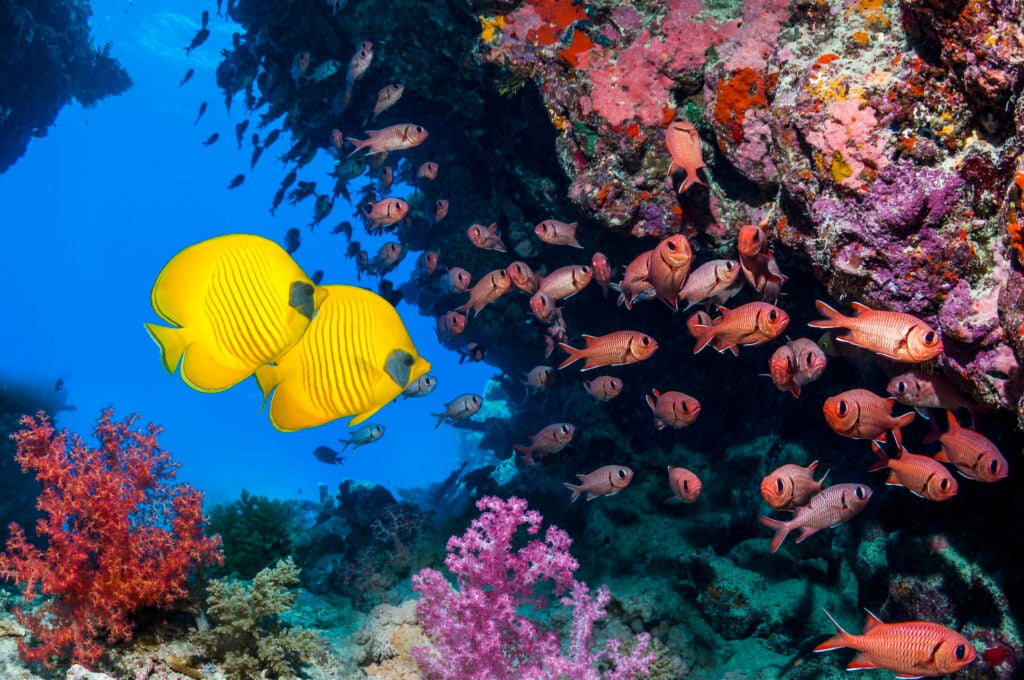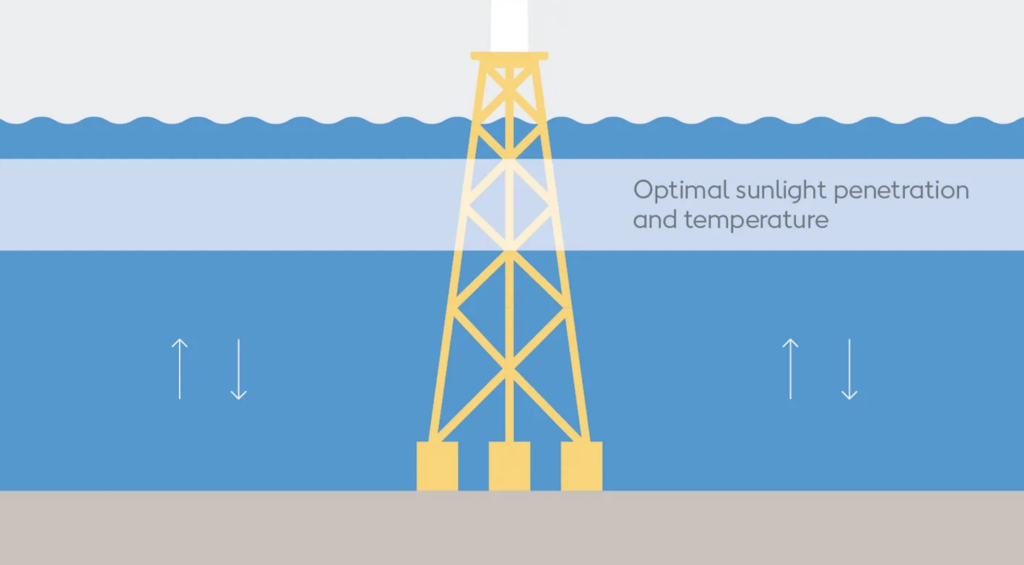“Sadly, we have taken the ocean for granted and today we face what I would call an ocean emergency,” UN secretary-general António Guterres said at the opening of the UN Ocean Conference in Lisbon on 27 June 2022. “We must turn the tide.”
Ocean heating and acidification, sea-level rise and greenhouse gas concentrations all hit record levels last year, according to the World Meteorological Organization’s State of the Global Climate 2021 report. Overfishing is laying waste to fish stocks and marine pollution is creating vast dead zones; populations of species such as sharks and rays have withered by more than 70% in the past 50 years.

One potential solution to counter marine biodiversity loss has emerged from an unlikely source: offshore wind farms. In a world first, marine biologists last month planted coral larvae at the base of offshore wind turbines in an attempt to grow new reefs off the coast of Taiwan. In fact, the idea represents just one of a number of ways scientists are teaming up with wind developers to turn offshore wind farms into safe havens for biodiversity.
Foundations for coral growth
Coral reefs provide habitats for around 32% of marine species and benefit – either directly or indirectly – more than one billion people, according to the UN Environment Programme. However, global warming is heating up the surface of the ocean, causing mass ‘bleaching’ events that are killing off tropical coral reefs and the ecosystems that depend on them.
Danish energy giant Ørsted has designed an innovative approach to combat the problem called ReCoral. The project involves collecting indigenous coral spawn as it washes ashore to plant new coral colonies on the foundations of nearby offshore wind turbines.
The waters of offshore wind farms further from shore tend to benefit from more stable temperatures than the shallower locations in which tropical coral reefs typically set up shop, because of a phenomenon called ‘vertical mixing’ in the water column. ReCoral aims to find out whether coral can grow on the foundations of offshore wind turbines – close enough to the surface to receive sufficient sunlight – to reduce the risk of catastrophic bleaching events.

Ørsted launched the project in 2020 and last year successfully grew juvenile corals on steel and concrete substrates at a quayside test facility. In June 2022, the developer started an offshore proof of concept trial on four turbines at the Greater Changua offshore wind farm off the coast of Taiwan.
Working with Taiwan's Penghu Marine Biology Research Centre, Ørsted has developed a non-invasive methodology for coral seeding, in vitro fertilisation, larvae transport and attachment of the larvae to the turbine foundations. Instead of extracting from existing coral colonies, ReCoral collects surplus coral egg bundles that would have otherwise died after washing ashore.
If the trial succeeds, Ørsted aims to scale-up the initiative and even use new coral larvae spawned on the wind farms to help restore existing near-shore reef systems. Ørsted believes the ReCoral concept has the potential to be applied to all offshore wind farms in tropical waters around the world.
“In times when we are facing an unprecedented loss of natural coral reefs, the potential benefits offered by an initiative such as ReCoral are music to my ears,” says Ove Hoegh-Guldberg, professor of marine studies at the University of Queensland in Brisbane, Australia. “The foundations of offshore wind turbines will create new offshore habitat. This habitat may be located in thermal niches that offer a Noah’s Ark-type effect.”
Turbine reefs: offshore wind biodiversity havens
It is not just coral that stands to benefit from offshore wind farms. Other approaches aim for different marine conservation impacts. In a separate project, Ørsted last month teamed up with the World Wildlife Fund (WWF) to deploy 12 3D-printed reef structures on the seabed between the wind turbines of the Anholt Offshore Wind Farm in the Kattegat, part of the Greater North Sea ecosystem near Denmark.
Issues such as overfishing, depleted oxygen levels and habitat loss have crippled the Kattegat’s cod stocks in the past 20 years. This has had a domino effect on the surrounding ecosystem, diminishing its biodiversity and reducing its resilience against climate-related changes.
The two partners hope the project will have a positive impact on the Kattegat’s cod population, and consequently the surrounding ecosystem. The 3D-printed reefs have a wedding-cake structure consisting of several levels that are connected to each other by hollows, where fish can swim in and out of hiding places. The structures themselves will also provide surfaces and crevices where other organisms can attach.
Having witnessed how the boulder reefs Ørsted laid when constructing the Anholt Offshore Wind Farm created oases of marine species on an otherwise barren seabed, the partners hope the new 3D-printed reefs will complement their original cousins and quickly become inhabited with life.
[Keep up with Energy Monitor: Subscribe to our weekly newsletter]
“Marine biodiversity in Denmark is under heavy pressure, and today there are 90% fewer cod in the Kattegat than in 1990. Action is needed – and urgently,” says Bo Oksnebjerg, secretary-general of WWF Denmark. “We must give nature and wildlife a hand, while trying to solve our climate crisis by expanding our renewable energy production at the same time.”
At the corporate level, Ørsted has set itself the goals of having a net-positive biodiversity impact for all its new renewable energy projects by 2030. It is working with ecologists on a number of other biodiversity-enhancing projects. For example, it is collaborating with Dutch non-profit ARK Nature on a pioneering rewilding project initially focused on restoring shellfish reefs in the North Sea and with two local wildlife trusts in a biodiversity restoration project on the Humber estuary on the east coast of Northern England. The latter involves planting three hectares of salt marshes and four hectares of seagrass, as well as creating a biogenic reef by introducing half a million native oysters.
Over in the US, non-profit the Nature Conservancy (TNC) is examining whether the bases of offshore wind turbines can be redesigned to create more hospitable habitats for marine life. Thus far, offshore wind turbines have been designed purely for function and cost, but now, says Chris McGuire, Ocean Program Director for TNC in Massachusetts, the organisation is collaborating with engineers “to design for nature as well”.
Offshore wind turbines need protection from erosion at their base. Anyone who has ever stood in the surf feeling the tide pulling away the sand from their feet will understand why. To date, developers have used heavy rocks the size of car tires for this purpose. However, TNC has conducted research on which materials and shapes are best suited to fostering marine habitats, compiling a catalogue of the best products that can “encourage a more diverse assemblage of marine life”, says Kate Wilke, fisheries scientist for the Nature Conservancy in Virginia.
This kind of habitat creation has shown promising results in restoration projects TNC has undertaken in nearshore coastal waters around the world, continues Wilke, but it has yet to be tested in deep ocean waters. TNC’s experts will now test the products at wind turbines being installed off the US Atlantic coast and examine which materials and configurations best interact with the native fauna.
These “turbine reefs” would entail extra costs for the wind developers due to price of the materials and the added design criteria in the project planning phase. However, “we know there are impacts to fishing communities from the development of offshore wind, and so you could potentially solve some of those cost issues by intentionally factoring in the enhancement of fisheries”, says Carl LoBue, TNC’s New York oceans program director.
If that sounds a touch counterintuitive for conservation, LoBue also points out that under US regulations, offshore wind developers must remove all the materials when the turbines are decommissioned after their 30-year lifespan. However, he foresees exemptions to those regulations if a developer can show it created healthy marine habitats out of those materials in the process. “A lot of rocks and materials have to be put in the water to shore up the base of these turbines, so it has the potential to be a tremendous cost-saving,” he says.
Repopulating the blue planet
Climate change is fast becoming the leading driver of biodiversity loss, and the expansion of the offshore wind industry holds the potential to help tackle both interlinked crises. Around the world, governments are busy planning huge offshore wind projects that, if done right, can accelerate the energy transition while also turning the tide on the mass marine extinction event that has long been under way.
Vast tracts of ocean are currently being set aside as future locations for wind farms. According to the consultancy McKinsey & Company, global installed offshore wind capacity is expected to reach 630GW by 2050, up from a mere 40GW in 2020. In the US, there are only a handful of turbines in state or federal waters offshore right now; by 2035, there will be more than 2,000 off the Atlantic coast alone.
In Europe, EU energy ministers have agreed their position on changes to the EU Renewable Energy Directive, paving the way for the faster buildout of renewables and streamlined permitting for wind farms. The EU now wants 510GW of onshore and offshore wind energy by 2030, up from 190GW today – that is 39GW of new wind farms every year. The European Commission also published its Nature Protection Package in June, enshrining in EU law a 20% binding restoration target of European land and seas.
“With REPowerEU’s new permitting rules and the Nature Protection Package, member states now have a full picture of the good working balance between biodiversity and renewables expansion,” said Giles Dickson, CEO of industry association WindEurope, in a press release on 22 June.
Historically, only a handful of markets – primarily the UK, China and Germany – have had the resources and engineering expertise to develop offshore wind, but this is set to change in the coming years. The 18 countries that currently produce offshore wind power are set to be joined by another 17 by 2030, with countries including India, Italy, Poland, Australia and Saudi Arabia all building their first offshore wind farms, according to research from GlobalData, Energy Monitor’s parent company.
All across the blue planet, there is set to be a massive expansion of offshore wind infrastructure. If some of the aforementioned conservation approaches prove fruitful, that expansion could well prove to be the dawning of a new era for marine biodiversity too.
“As we buildout offshore wind energy, there is great potential to enhance and create new habitats,” concludes LoBue. “Offshore wind farms could support entire communities of marine life.”



